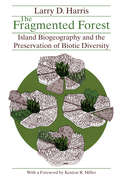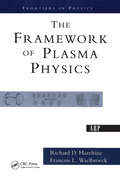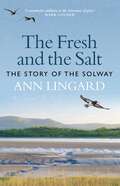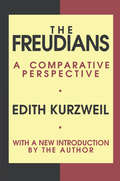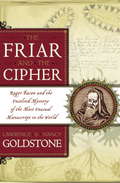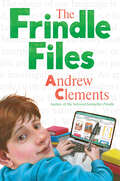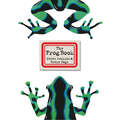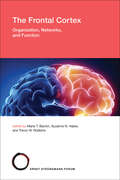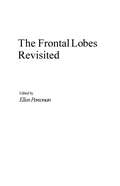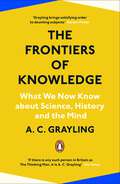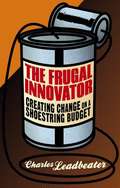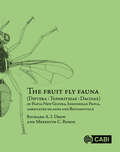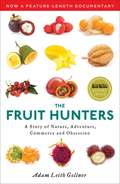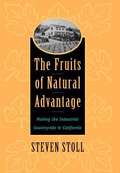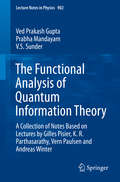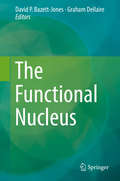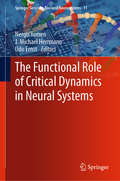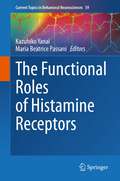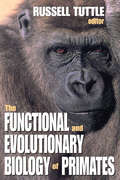- Table View
- List View
The Fragmented Forest: Island Biogeography Theory and the Preservation of Biotic Diversity
by Larry D. HarrisIn this poineering application of island biogeography theory, Harris presents an alternative to current practices of timber harvesting. "Harris pulls together many threads of biological thinking about islands and their effect on plant and animal survival and evolution. He weaves these threads into a model for managing forest lands in a manner that might serve both our short-term economic and social needs as well as what some people feel is our ancient charge to be steward of all parts of creation."--American Forests Winner of the 1986 Wildlife Society Publication Award
The Framework Of Plasma Physics
by Richard D. HazeltinePlasma physics is a necessary part of our understanding of stellar and galactic structure. It determines the magnetospheric environment of the earth and other planets; it forms the research frontier in such areas as nuclear fusion, advanced accelerators, and high power lasers; and its applications to various industrial processes (such as computer chip manufacture) are rapidly increasing. It is thus a subject with a long list of scientific and technological applications. This book provides the scientific background for understanding such applications, but it emphasizes something else: the intrinsic scientific interest of the plasma state. It attempts to develop an understanding of this state, and of plasma behavior, as thoroughly and systematically as possible. The book was written with the graduate student in mind, but most of the material would also fit into an upper-level undergraduate course.
The Fresh and the Salt: The Story of the Solway
by Ann Lingard“Beautiful, intensely visual prose, born from deep intimacy with subtle borderlands: land and sea, England and Scotland, people and environments.” —David Gange, author of The Frayed Atlantic EdgeFirths and estuaries are liminal places, where land meets sea and tides meet freshwater. Their unique ecosystems support a huge range of marine and other wildlife: human activity too is profoundly influenced by their waters and shores.The Solway Firth—the crooked finger of water that both unites and divides Scotland and England—is a beautiful yet unpredictable place and one of the least-industrialized natural large estuaries in Europe. Its history, geology and turbulent character have long affected the way its inhabitants, both human and non-human, have learnt to live along and within its ever-changing margins.“Lingard’s scientific knowledge of the area and its multitudinous inhabitants [is] delivered in riveting prose. This is deep and beautiful natural history writing.” —BBC Countryfile Magazine“Like a hungry gull, Ann Lingard explores her beloved Solway shoreline for every living detail that catches her eye. In so doing she has created a portrait of this nation-cleaving water that is as broad and deep as the estuary itself.” —Mark Cocker, author of Birds & People“A kaleidoscopic portrait of the borders of the land.” —Cumbria Life“Lingard writes vividly about this estuary . . . an excellent point of reference for locals, visitors and for those simply intrigued by this lesser-known corner of Scotland.” —Scottish Field
The Freshwater Alphabet Book (Jerry Pallotta's Alphabet Books)
by Jerry PallottaCome take a swim with freshwater creatures from around the world! Meet a fish that has no eyes and one that has four of them. Get to know an eel that carries enough electricity to light up a light bulb and a glacier-dwelling worm with blood that works like antifreeze.Jerry Pallotta has done it again! The acclaimed alphabet-book author has joined forces with illustrator David Biedrzycki to create an exquisite and informative introduction to freshwater dwellers.
The Freud Files: An Inquiry into the History of Psychoanalysis
by Sonu Shamdasani Mikkel Borch-JacobsenHow did psychoanalysis attain its prominent cultural position? How did it eclipse rival psychologies and psychotherapies, such that it became natural to bracket Freud with Copernicus and Darwin? Why did Freud 'triumph' to such a degree that we hardly remember his rivals? This book reconstructs the early controversies around psychoanalysis and shows that rather than demonstrating its superiority, Freud and his followers rescripted history. This legend-making was not an incidental addition to psychoanalytic theory but formed its core. Letting the primary material speak for itself, this history demonstrates the extraordinary apparatus by which this would-be science of psychoanalysis installed itself in contemporary societies. Beyond psychoanalysis, it opens up the history of the constitution of the modern psychological sciences and psychotherapies, how they furnished the ideas which we have of ourselves and how these became solidified into indisputable 'facts'.
The Freudians: A Comparative Perspective
by Edith KurzweilEvery country unconsciously creates the psychoanalysis it needs, says Edith Kurzweil. Freudians everywhere, even the most orthodox, are influenced by national traditions, interests, beliefs, and institutions. In this original and stimulating book, Kurzweil traces the ways in which psychoanalysis has evolved in Austria, England, France, Germany, and the United States.The author explains how psychoanalysis took root in each country, outlines the history of various psychoanalytic institutes, and describes how Freudian doctrine has been transmuted by aesthetic values, behavioral mores, and political traditions of different cultures. The Germans, for example, took Austrian humanism and made it "scientific." The British developed object relations. French psychoanalysts emphasized linguistics and structuralism and developed an abiding fascination with text, language, subtext, and plot structures.In her new introduction, Kurzweil reexamines her argument that countries develop their own psychoanalysis according to their needs. She describes evidence supporting her theories and why they continue to hold true today. She also discusses what led her to write this book initially. The Freudians is a major work in confirming the importance of psychoanalytic thought across national and cultural boundaries.
The Friar and the Cipher: The Unsolved Mystery of the Most Unusual Manuscript in the World
by Lawrence Goldstone Nancy GoldstoneA compulsively readable account of the most mysterious manuscript in the world, one that has stumped the world's greatest scholars and codebreakers. The Voynich Manuscript, a mysterious tome discovered in 1912 by the English book dealer Wilfrid Michael Voynich, has puzzled scholars for a century. A small six inches by nine inches, but over two hundred pages long, with odd illustrations of plants, astrological diagrams, and naked women, it is written in so indecipherable a language and contains so complicated a code that mathematicians, book collectors, linguists, and historians alike have yet to solve the mysteries contained within. However, in The Friar and the Cipher, the acclaimed bibliophiles and historians Lawrence and Nancy Goldstone describe, in fascinating detail, the theory that Roger Bacon, the noted thirteenth-century, pre-Copernican astronomer, was its author and that the perplexing alphabet was written in his hand. Along the way, they explain the many proposed solutions that scholars have put forth and the myriad attempts at labeling the manuscript's content, from Latin or Greek shorthand to Arabic numerals to ancient Ukrainian to a recipe for the elixir of life to good old-fashioned gibberish. As we journey across centuries, languages, and countries, we meet a cast of impassioned characters and case-crackers, including, of course, Bacon, whose own personal scientific contributions, Voynich author or not, were literally and figuratively astronomical. The Friar and the Cipher is a wonderfully entertaining and historically wide-ranging book that is one part The Code Book, one part Possession, and one part The Da Vinci Code--and will appeal to bibliophiles and laypeople alike.
The Friendship Experiment
by Erin TeaganFuture scientist Madeline Little is dreading the start of middle school. Nothing has been right since her grandfather died and her best friend changed schools. Maddie would rather help her father in his research lab or write Standard Operating Procedures in her lab notebook than hang out with a bunch of kids who aren't even her friends. Despite Maddie's reluctance, some new friends start coming her way--until they discover what she's written in that secret notebook. And that's just part of the trouble. Can this future scientific genius find the formula for straightening out her life?
The Frindle Files
by Andrew ClementsIn the long-awaited follow-up to the beloved classic Frindle, a new generation of kids discovers the power of words and imagination – and yes, even screens – to solve a mystery and change their world! &“A fitting final work from a master storyteller.&”—Kirkus Reviews Josh Willet is a techie, a serious gamer. Which is why Josh and his friends can&’t stand Mr. N&’s ELA class; it&’s a strict no-tech zone. Mr. N makes them write everything out by hand, he won&’t use a Smartboard, and he&’s obsessed with some hundred-year-old grammar book. Then Josh discovers a secret; turns out Mr. N's been keeping a lot more than technology from his students! Together with his best friend Vanessa, and using all the computer skills they&’ve got, Josh is determined to solve the mystery of Mr. N&’s past. And maybe get some screentime back, too? Andrew Clements&’s final novel is a timely one—about the importance of language, the changes that come along with technology (good and bad), and how sometimes you have to challenge what you think you know. Set a whole generation later, this novel can be read on its own or alongside Frindle and is destined to become another timeless classic.
The Frog Alphabet Book (Jerry Pallotta's Alphabet Books)
by Jerry PallottaA is for Amazon Horned Frog. B is for Blue-legged Strawberry Frog. C is for Crested Newt. What other amphibians can you think of? Learn more about these sometimes cute, sometimes dangerous, but always fascinating animals in THE FROG ALPHABET BOOK. Jerry Pallotta and Ralph Masiello explore the ponds, look under rocks, and dig in the mud to bring you this colorful and fun way to learn more than the alphabet.
The Frog Book
by Steve Jenkins Robin PageCaldecott Honor–winning team Steve Jenkins and Robin Page explore form, color, and pattern, and capture the very unique nature of frogs in this brilliantly illustrated picture book. Perfect for fans of The Beetle Book, and young readers looking for nonfiction about this perennially fascinating animal.Long legs, sticky tongues, big round eyes, and other dazzling features—what's not to love about frogs? In this magnificently illustrated picture book, Caldecott Honor–winning team Steve Jenkins and Robin Page explore one of the world's most diverse—and most threatened—animals. With more than 5,000 different frog species on the planet, in every color of the rainbow and a vast number of vivid patterns, no creatures are more fascinating to learn about or look at. Jenkins and Page present a stunning array of these intriguing amphibians and the many amazing adaptations they have made to survive.
The Frontal Cortex: Organization, Networks, and Function (Strüngmann Forum Reports #35)
by Trevor W. Robbins Marie T. Banich Suzanne N. HaberAn in-depth investigation of the structure, neuronal mechanisms, and computations of the frontal lobe that enable higher-level thought.Experts from neurobiology, neuroanatomy, evolutionary biology, cognitive neuroscience, computational neuroscience, and clinical science examine how the neuronal structure of the frontal lobes enables unique aspects of higher-level thought. Implications for understanding disrupted function in neurological and psychiatric disorders, as well as societal issues, such as volitional control of behavior and educational practice, are also considered.
The Frontal Lobes Revisited (Institute for Research in Behavioral Neuroscience Series)
by Ellen PerecmanExperts in neuropsychology examine key issues in research involving the frontal lobes.
The Frontiers of Knowledge: What We Know About Science, History and The Mind
by A. C. Grayling'Grayling brings satisfying order to daunting subjects' Steven Pinker_________________________In very recent times humanity has learnt a vast amount about the universe, the past, and itself. But through our remarkable successes in acquiring knowledge we have learned how much we have yet to learn: the science we have, for example, addresses just 5 per cent of the universe; pre-history is still being revealed, with thousands of historical sites yet to be explored; and the new neurosciences of mind and brain are just beginning. What do we know, and how do we know it? What do we now know that we don't know? And what have we learnt about the obstacles to knowing more? In a time of deepening battles over what knowledge and truth mean, these questions matter more than ever. Bestselling polymath and philosopher A. C. Grayling seeks to answer them in three crucial areas at the frontiers of knowledge: science, history and psychology. A remarkable history of science, life on earth, and the human mind itself, this is a compelling and fascinating tour de force, written with verve, clarity and remarkable breadth of knowledge._________________________'Remarkable, readable and authoritative. How he has mastered so much, so thoroughly, is nothing short of amazing' Lawrence M. Krauss, author of A Universe from Nothing'This book hums with the excitement of the great human project of discovery' Adam Zeman, author of Aphantasia
The Frozen Zoo (Fountas & Pinnell Classroom, Guided Reading Grade 6)
by Tina KafkaHARD CHOICES Human activities cause the extinction of many thousands of unique species every year. As the clock runs down toward the loss of even more species, scientists and conservationists face hard choices. Which species are most important to save? What is the best method to save them? The Frozen Zoo stores thousands of frozen cells from endangered animals. This collection offers a new way to help save species for future generations. NIMAC-sourced textbook
The Frugal Innovator
by Charles LeadbeaterThis insightful book looks at the phenomenon of low-cost innovation and explores what we can learn from the innovators in developing nations who are making amazing technical and social advances with scarce capital and resources. Charles Leadbeater shows how these methods can be applied and used wherever you are and whatever your capital.
The Fruit Fly Fauna (Diptera : Tephritidae : Dacinae) of Papua New Guinea, Indonesian Papua, Associated Islands and Bougainville
by Richard Drew Meredith C RomigThe book is a taxonomic treatise of the tropical fruit flies of Papua New Guinea, Indonesian Papua, associated islands and Bougainville, the region of the world where speciation in the sub-family Dacinae has been most prolific. The book aims to provide readers with an updated record of all known species of Dacinae that occur in this geographic area including descriptions of 65 new species out of an entire list of 296 known species covered. It provides a discussion on the evolutionary origins of the Dacinae and a key to the genera and sub-genera recorded in the Australian-Pacific Region. Further, the major pest species and their biosecurity risks to other countries are discussed. Extensive field research by the authors and colleagues over many years has resulted in the accumulation of advanced knowledge of the tropical fruit flies in this region. - Records 296 known species - Descriptions and artwork of 65 new species - Discusses the evolutionary origins of the Dacinae - Provides a key to the genera and sub-genera in the Australian-Pacific A key reference for researchers of taxonomy, ecology and pest management in the family Tephritidae worldwide. Useful for biosecurity and horticulture workers in Agriculture Departments within government administration and universities around the world.
The Fruit Hunters: A Story of Nature, Adventure, Commerce, and Obsession
by Adam Leith GollnerDelicious, lethal, hallucinogenic and medicinal, fruits have led nations to war, fueled dictatorships and lured people into new worlds. An expedition through the fascinating world of fruit, The Fruit Hunters is the engrossing story of some of Earth's most desired foods. In lustrous prose, Adam Leith Gollner draws readers into a Willy Wonka-like world with mangoes that taste like piña coladas, orange cloudberries, peanut butter fruits and the miracle fruit that turns everything sour to sweet, making lemons taste like lemonade. Peopled with a cast of characters as varied and bizarre as the fruit -- smugglers, inventors, explorers and epicures -- this extraordinary book unveils the mysterious universe of fruit, from the jungles of Borneo to the prized orchards of Florida's fruit hunters to American supermarkets. Gollner examines the fruits we eat and explains why we eat them (the scientific, economic and aesthetic reasons); traces the life of mass-produced fruits (how they are created, grown and marketed) and explores the underworld of fruits that are inaccessible, ignored and even forbidden in the Western world. An intrepid journalist and keen observer of nature -- both human and botanical -- Adam Leith Gollner has written a vivid tale of horticultural obsession.
The Fruits of Natural Advantage: Making the Industrial Countryside in California
by Steven StollSteven Stoll explains how a class of capitalist farmers made California the nation's leading producer of fruit and created the first industrial countryside in America. This brilliant portrayal of California from 1880 to 1930 traces the origins, evolution, and implications of the fruit industry.
The Functional Analysis of Quantum Information Theory
by Ved Prakash Gupta Prabha Mandayam V. S. SunderThis book provides readers with a concise introduction to current studies on operator-algebras and their generalizations, operator spaces and operator systems, with a special focus on their application in quantum information science. This basic framework for the mathematical formulation of quantum information can be traced back to the mathematical work of John von Neumann, one of the pioneers of operator algebras, which forms the underpinning of most current mathematical treatments of the quantum theory, besides being one of the most dynamic areas of twentieth century functional analysis. Today, von Neumann's foresight finds expression in the rapidly growing field of quantum information theory. These notes gather the content of lectures given by a very distinguished group of mathematicians and quantum information theorists, held at the IMSc in Chennai some years ago, and great care has been taken to present the material as a primer on the subject matter. Starting from the basic definitions of operator spaces and operator systems, this text proceeds to discuss several important theorems including Stinespring's dilation theorem for completely positive maps and Kirchberg's theorem on tensor products of C*-algebras. It also takes a closer look at the abstract characterization of operator systems and, motivated by the requirements of different tensor products in quantum information theory, the theory of tensor products in operator systems is discussed in detail. On the quantum information side, the book offers a rigorous treatment of quantifying entanglement in bipartite quantum systems, and moves on to review four different areas in which ideas from the theory of operator systems and operator algebras play a natural role: the issue of zero-error communication over quantum channels, the strong subadditivity property of quantum entropy, the different norms on quantum states and the corresponding induced norms on quantum channels, and, lastly, the applications of matrix-valued random variables in the quantum information setting.
The Functional Nucleus
by David P. Bazett-Jones Graham DellaireThis book gives an in-depth overview on nuclear structure and function. It clearly shows that the epigenome and the three-dimensional organization of the nucleus are not independent properties. The intimate relationship between the location and the epigenetic modifications of gene loci is highlighted. Finally, it shows that the complex three-dimensional organization of the nucleus is not just of academic interest: The structure, composition and function of virtually all of the sub-nuclear compartments identified so far can be implicated to a list of human genetic diseases. Hence, a detailed elucidation of how these domains are assembled and function will provide new opportunities for therapeutic intervention in clinical practice.
The Functional Role of Critical Dynamics in Neural Systems (Springer Series on Bio- and Neurosystems #11)
by Nergis Tomen J. Michael Herrmann Udo ErnstThis book offers a timely overview of theories and methods developed by an authoritative group of researchers to understand the link between criticality and brain functioning. Cortical information processing in particular and brain function in general rely heavily on the collective dynamics of neurons and networks distributed over many brain areas. A key concept for characterizing and understanding brain dynamics is the idea that networks operate near a critical state, which offers several potential benefits for computation and information processing. However, there is still a large gap between research on criticality and understanding brain function. For example, cortical networks are not homogeneous but highly structured, they are not in a state of spontaneous activation but strongly driven by changing external stimuli, and they process information with respect to behavioral goals. So far the questions relating to how critical dynamics may support computation in this complex setting, and whether they can outperform other information processing schemes remain open. Based on the workshop “Dynamical Network States, Criticality and Cortical Function", held in March 2017 at the Hanse Institute for Advanced Studies (HWK) in Delmenhorst, Germany, the book provides readers with extensive information on these topics, as well as tools and ideas to answer the above-mentioned questions. It is meant for physicists, computational and systems neuroscientists, and biologists.
The Functional Roles of Histamine Receptors (Current Topics in Behavioral Neurosciences #59)
by Maria Beatrice Passani Kazuhiko YanaiResearch in the field of histamine receptors over the past 100 years went hand-in-hand with the development of modern pharmacology. Advances in histamine research led by outstanding scientists was so incisive that the clinical approach to treat allergies and gastrointestinal ailments was revolutionized. The pharmacological treatment of peptic ulcer and gastroesophageal reflux was indeed a revolution, as it ended the surgical intervention. Interest in histamine pharmacology was resurrected by the discovery of another histamine receptor, number 4, using genomics-based reverse pharmacological approaches for screening orphan GPCRs. This receptor is preferentially expressed by immune cells and its discovery raised hopes for its translational exploitation as a new therapeutic target for unmet medical needs ranging from asthma to cancer. However, several drawbacks emerged and dramatically slowed down research in the field. A better understanding of receptor intra-and interspecies heterogeneity will certainly improve and accelerate the translation of experimental data into clinical practice. Also, the plethora of data on brain histamine is hinting at a fundamental role of this system as a hub that receives internal and peripheral stimuli to allocate the necessary excitation to specific brain circuits that preside the appropriate behavioral responses. The development of new histaminergic ligands is an ongoing process that constantly provide new preclinical tools. The aim of this book is to cover the most important aspects of histamine receptor function and pharmacology in the central nervous system and to provide a comprehensive overview of the preclinical and clinical advances made in recent decades and the exciting prospects for the future. It highlights the clinical areas where there is a great need for new therapeutic approaches and where novel histaminergic agents may be useful for personalized medicine.
The Functional and Evolutionary Biology of Primates
by Russell TuttleThese original contributions on the evolution of primates and the techniques for studying the subject cover an enormous range of material and incorporate the work of specialists from many different fields, showing the necessity of a multidisciplinary approach to problems of primate morphology and phylogeny. Collectively, they demonstrate the concerns and methods of leading contemporary workers in this and related fields. Each contributor shows his way of attacking fundamental problems of evolutionary primatology.
